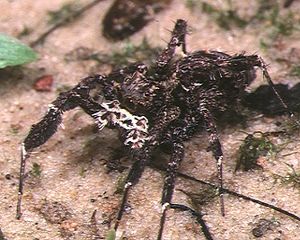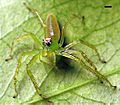Portia fimbriata facts for kids
Quick facts for kids Portia fimbriata |
|
|---|---|
 |
|
| Female P. fimbriata | |
| Scientific classification | |
| Synonyms | |
|
The Portia fimbriata, also known as the fringed jumping spider, is a type of jumping spider. It belongs to the Salticidae family. You can find this spider in Australia and Southeast Asia.
Contents
What Does the Fringed Jumping Spider Look Like?
Adult female P. fimbriata spiders are about 6.8 to 10.5 millimeters long. Males are a bit smaller, measuring 5.2 to 6.5 millimeters. Both male and female spiders usually have a dark brown carapace (the top part of their body). Their chelicerae (fangs) are reddish brown. The underside of their body is brown. They have dark brown palps with white hairs. Their abdomen (the back part of their body) is dark brown with white spots on top.
These spiders have fine, light markings and soft, fringed hairs. Their legs are thin and also fringed. However, some spiders from New Guinea and Indonesia look a bit different. They have orange-brown carapaces and yellowish abdomens. When any Portia spider has eaten well or is making eggs, its abdomen gets bigger.
How Does Portia fimbriata Behave?
Hunting Cleverly
Portia spiders are very smart hunters. They can change their hunting plans to catch different prey. They have natural hunting tricks for common prey. But if they meet new prey or are in a new place, they can try different ways to hunt. They learn from their mistakes and remember what works best.
Different groups of P. fimbriata hunt in slightly different ways. Spiders from Australia's Northern Territory are not very good at hunting other jumping spiders. But they are better at catching web-building spiders (not jumping spiders) and insects. Spiders from Sri Lanka are okay at hunting other jumping spiders. They are good at catching web spiders and insects.
The P. fimbriata from Queensland are amazing hunters of other jumping spiders and web spiders. But they are not very good at catching insects. The Queensland spiders use a special trick called "cryptic stalking." This makes other jumping spiders not even see them as a predator, or even as an animal at all! Some prey spiders can partly defend against this trick. Sometimes, prey spiders try to fight back. But all Portia spiders have very strong defenses, like tough skin.
Reproduction and Mating Habits
When a P. fimbriata meets another spider of its own kind, it doesn't use cryptic stalking. Instead, it moves quickly and smoothly to show itself. In Queensland P. fimbriata, fights between males are usually short and don't cause harm. Fights between female Portia spiders are often long and rough. The winner might kick out the loser and then eat the loser's eggs. But female P. fimbriata from Queensland do not kill and eat the losing female.
If a male P. fimbriata from Queensland shows off to a female, she might run away or charge at him. If they agree after this, they will mate if she is an adult. If she is almost an adult, the male will live in her nest until she sheds her skin. Then they will mate. Unlike other Portia species, female P. fimbriata do not eat their mates during courtship, or during or after mating.
Where Does Portia fimbriata Live?
You can find P. fimbriata in the rainforests of India, Nepal, Sri Lanka, Hong Kong, Taiwan, New Guinea, the Solomon Islands, Malaysia (including Malacca), Indonesia, and in Australia's Northern Territory and Queensland.
These spiders live on leaves, tree trunks, large rocks, and rock walls. This is the most common Portia species in all the places it lives. Queensland P. fimbriata live near running water and in places with medium light. Northern Territory spiders live in caves, where it's quite dark at the back but brighter near the cave openings. Other Portia groups live in brighter places. Some even live in webs that get direct sunlight for part of the day.
In Queensland, P. fimbriata shares its home with a common prey spider called Jacksonoides queenslandicus. It also lives with many other jumping spiders (not Portia) and web-building spiders.
It can be hard to find P. fimbriata in the wild. Their shape and movements help them blend in very well. The Queensland type is easy to keep in captivity, but the Northern Territory type is quite difficult to care for.
Who Hunts Portia fimbriata?
Ants hunt P. fimbriata. However, P. fimbriata spiders do not hunt ants. They seem to think ants are poisonous or taste very bad. Other animals that hunt P. fimbriata include birds, frogs, and mantises.
Images for kids




